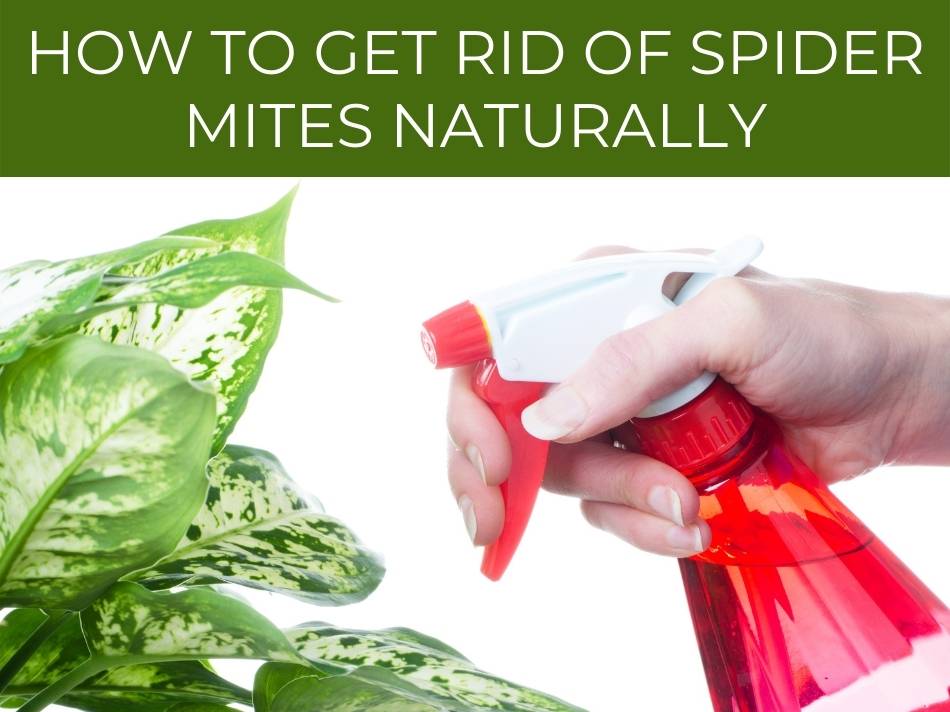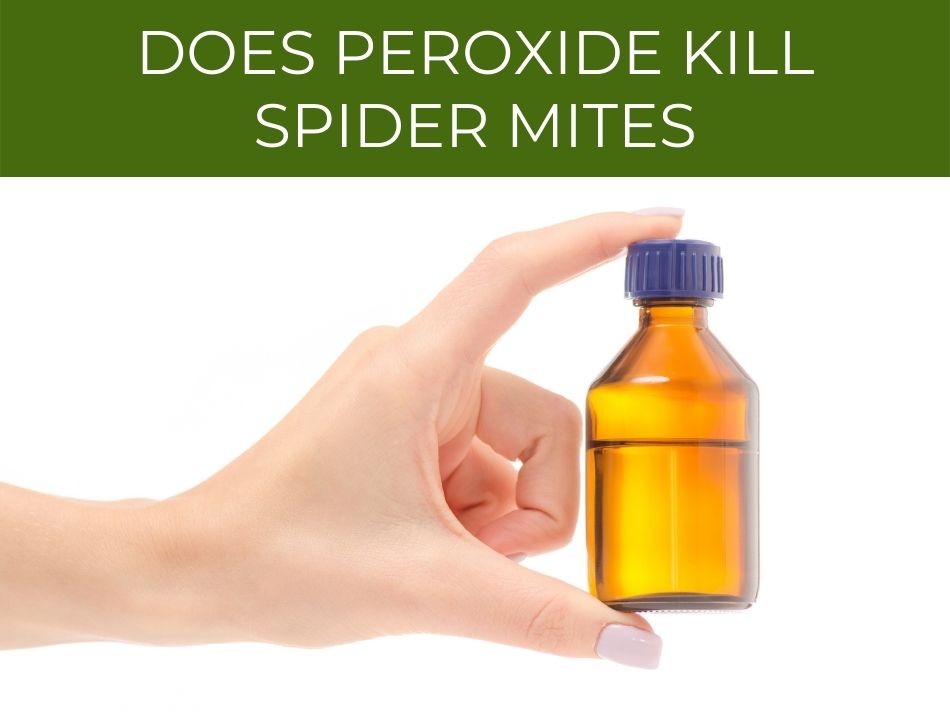Do you want to know how to get rid of spider mites in your garden? They’re one of the most troublesome pests in the garden since they’re so tiny that it’s hard to notice them before they start showing signs of damage on the plants. However, once you do identify spider mites, there are several ways to get rid of them.
Insecticidal soaps, horticultural oils, & diatomaceous earth are effective in getting rid of spider mites. Rubbing alcohol on the foliage, introducing natural predators, & spraying with dish soap (diluted to 2 – 3%) or peroxide (using a 3% solution) have also been shown to get rid of spider mites.
Getting rid of spider mites can involve a variety of biological and chemical control methods.Identify what works best for your plants without causing any damage to the plant itself before employing a control technique.

How To Get Rid Of Spider Mites In Your Garden
Getting rid of spider mites in the garden starts with careful detection of the pest that’s causing the damage.
White webbing on the underside of leaves, yellow, white or tan spots on the leaves, and tiny white or red insects moving about on the leaves are all indications that the plant is attacked by spider mites.
Driving away spider mites from your garden is possible by introducing natural predators and making the garden welcoming to them. Ladybugs, thrips, and lacewings feed on spider mites, naturally keeping their population down in pesticide-free gardens.
Limiting the use of pesticides and preventing dusty conditions encourages these natural predators that help get rid of spider mites from your garden.
Growing flowering plants like geraniums, dandelions, caraway, dill and fennel also keeps the beneficial insects active.

How To Get Rid of White Mites On Tomato Plants
White mites love vegetable crops, including tomatoes.
If left untreated, they spin webs around the leaves, suck up the plant fluids, cause leaf drop and will severely affect yield.
Maintain the recommended watering and feeding schedule because healthy tomato plants will put up a better resistance against pest damage.
Biological control involves the introduction of predatory mites, including Galendromus occidentalis, and persimilis species. Introduce them at the rate of 10 predators per tomato plant, in addition to 1 or 2 for every infested leaf.
These predatory mites are commercially available for release on plants infested by spider mites and do not harm your plants.
How Do You Get Rid Of Spider Mites On Cucumber Plants
Similar to tomatoes, your cucumber plants are also susceptible to attack by spider mites.
If present in large numbers, they can cause defoliation and significantly reduce yield.
Spider mite population on cucumber crops can be suppressed by using commercially-available miticides.
Cover all the parts of the infested plants thoroughly, including the underside of the leaves which is where most of the population usually resides.
Since multiple generations of mites can exist in a single growing season, they might develop resistance to a miticide that’s being applied periodically.
To overcome this resistance, rotate miticides with different modes of actions within the lifecycle of spider mites.
Apart from mites, cucumbers are also susceptible to other problems.
Check out our article on identifying and resolving cucumber plant problems.
How To Get Rid Of Spider Mites On Vegetable Plants
Spider mites are a common pest problem encountered by vegetables growing in gardens and greenhouses.
Their life cycle can be as short as 8 days, which means several generations can exist in a single growing season.
Though spider mites primarily attack tomatoes, cucurbits and beans, beets, carrots, corn, pepper and other vegetable crops are also prone to attack.
Avoid using excessive nitrogen fertilizers and spray the plants with horticultural oils or insecticidal soap.
Employing floating row covers is also effective in preventing further mite infestations.
Keep the vegetable garden weed-free because mites overwinter on the surrounding weeds and reinfest the vegetables in the next growing season.
You may have to pull out and dispose of the heavily infested plants to prevent the mites from spreading to the rest of the vegetables.

How To Get Rid Of Spider Mites On Fig Tree
Fig trees are susceptible to both, two-spotted spider mites and Pacific spider mite.
Since they reproduce quickly, even a small infestation can become a big problem if not catered to on time.
Pesticides with bifenazate are effective in killing spider mites on fig trees.
If you apply such a pesticide, understand that the fruits from that tree should not be consumed for an entire year.
Only use a single application of the pesticide per year.
Alternatively, thrips and predaceous mites are effective in controlling spider mites on fig trees naturally.
Another common problem with fig trees is their roots: see our full guide on how to safely deal with fig tree roots.

How To Get Rid Of Spider Mites On Roses
Spider mites are prevalent pests in rose beds.
Typically, they become a problem in gardens where insecticides are used since these chemicals suppress the population of predatory insects, causing a problematic rise in mite population.
Spider mites thrive in hot, dry and dusty conditions.
Hose off the plants with water to dislodge the mites and keep the plants cool and clean.
Cut back the heavily infested branches and discard them.
Spray the rose plants with neem oil spray created by mixing a teaspoon of neem oil in 1 liter of water.
Repeat all the control techniques once each week to be effective.
Clean up the overwintering sites around the rose bush, including plant debris to prevent mites from reinfesting in the next season.

How To Get Rid Of Spider Mites On Desert Rose
If the foliage on your desert rose plants is covered with webs, you’re most likely dealing with spider mites.
These plants can harbor big populations of mites if the problem isn’t addressed promptly.
Insecticidal soaps are effective in treating desert roses infested by spider mites.
Follow the directions on the packaging of the insecticidal soap to mix it in water and spray it on the plants as directed.
Make sure you get the undersides of the leaves since that’s where most of the mites will hide.

How To Get Rid Of Spider Mites Naturally
You don’t always have to use chemicals to get rid of spider mites in your garden.
There are a range of natural techniques that can work as effectively against these pests as pesticides.
Spray down the infested plants with pressure water from the hose to dislodge the mites.
Water on the undersides of the leaves to hose off colonies of spider mites and their eggs from the plants.
Repeat this technique several times over a course of days until the spider mites are gone for good.
See more details & tips in the full article on how to get rid of spider mites naturally.

How To Keep Spider Mites Off Indoor Plants
Spider mites are a common problem that indoor gardeners face especially during the warm and dry environment created by heating systems in winters.
Spider mites feed on the stomata of the leaves on your plants, causing the leaves to shrivel and fall off.
If the problem isn’t addressed, mites can even weaken the houseplants enough to kill them.
Isolate the infested houseplant to prevent the mites from spreading to other potted plants.
Wipe the infested leaves with a sponge dipped in a mixture of one part rubbing alcohol and 3 parts water.
Allow the alcohol to stay on the plants for five hours before rinsing it off with water.
You may have to repeat the procedure every few days until the plant is completely rid of the pests.
Rubbing alcohol is also effective on other bugs, including whiteflies and aphids.
See our complete guide to identify and treat common pests in plant soil.
And check out the complete guide for how to kill spider mites on indoor plants.

Does Dish Soap Kill Spider Mites
According to Oregon State University, using a dish soap solution is an effective home remedy against spider mites.
Create the mixture using 3 tablespoons of dish soap and a gallon of water.
Transfer the mixture to a sprayer bottle and spray the infested plants with it thoroughly.
Remember to spray on the undersides of the leaves.
You may have to repeat the application every week or so before you can see effective results.
See the complete guide to using dish soap to kill spider mites.

Does Peroxide Kill Spider Mites
Hydrogen peroxide is effective in killing a number of insect pests, including spider mites.
Create a solution using 8 ounces of 3% hydrogen peroxide, 8 ounces of sugar and 1 gallon of water to spray on the infested plants.
The purpose of sugar is to help the mixture stick to the plants for longer, enhancing its effect.
Repeat the application every few weeks until the spider mites are completely eliminated.
Check out the full article on whether peroxide kills spider mites (and how to use it safely).

Conclusion
Though simple and easy to employ, the techniques highlighted above are all very effective in getting rid of spider mites from your garden.
Prompt detection of the pest and employing the right technique instantly to control it is the key to preventing any long term damage to the plants.

